Issues of the Louisburg College Student Newspaper are now online at DigitalNC.org. The available issues date from 1908 to 1998, covering the school’s transformation from an all-female institution to a coeducational one in 1931. The student newspaper underwent a number of title changes throughout the years, publishing as “Louisburg Echoes”, “The Gull”, “The Sea Thean” (a play on the two literary societies – the Sea Gift and the Neithean Society – that co-published the newspaper), and my personal favorite, the “Lo’ Co'”, before finally settling on “Columns” in the early 1940s. “Columns” is still published today as the school’s alumni magazine.
Mascots are a complicated phenomenon. They inspire a spectrum of reactions: ridicule, ambivalence, or fierce loyalty. With thousands of yearbooks online, all of us here at the Digital Heritage Center have probably spent more time looking at yearbooks than anyone else you’re likely to meet. Mascots are a common theme.
I’ve been working on today’s post for quite some time; unable to find a history or comprehensive list of mascots in North Carolina I decided to compile one myself. So here’s a stab at a college mascot overview, drawn from yearbooks and other campus publications. Let me know what I’ve missed or gotten wrong!
Children
In the early 20th century, schools frequently chose children as mascots or sponsors, whether for a sports team or for a particular class. The earliest example we’ve found on DigitalNC is from a 1910 publication by Atlantic Christian College (now Barton College) in Wilson, which shows Elizabeth Settle Caldwell as the Senior Class sponsor.
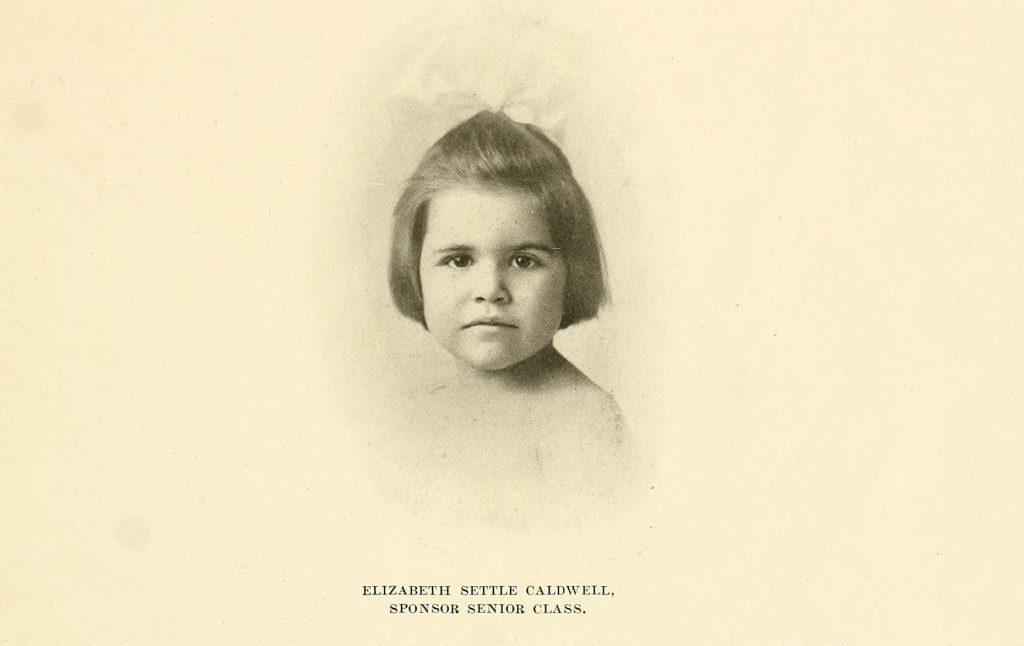
Elizabeth Settle Caldwell, First North Carolina Mascot? From the 1910 Pine Knot yearbook, Atlantic Christian College.
Ms. Caldwell was the daughter of Jesse Cobb Caldwell, the college president. From what we’ve been able to tell, children mascots were frequently younger siblings of students, teachers, or others associated with the school. Students mention that Ms. Caldwell brought “solace to many a lonely, homesick heart” and this may be why children were chosen – to foster a feeling of family and comfort among students. We’ve seen several references to mascots being elected or being chosen through competition, although what this might be we haven’t been able to discover. The trend of choosing children as mascots seems to continue through the 1960s. The latest one we found is Dawn, the Senior Class mascot at Peace College (now William Peace University) in 1966.
Animals
Animal mascots span schools across the state, whether it’s Rameses at UNC-Chapel Hill or WCU’s Catamount. The bulldog and different types of cats win out as most frequently adopted. Pictures of live animal mascots start to appear in yearbooks in the early 1900s, and continue today although much less frequently. For a variety of reasons, including concerns expressed by animal rights activists, schools have shifted away from actual animals to students dressing up like animals, as you’ll see later on in this post.
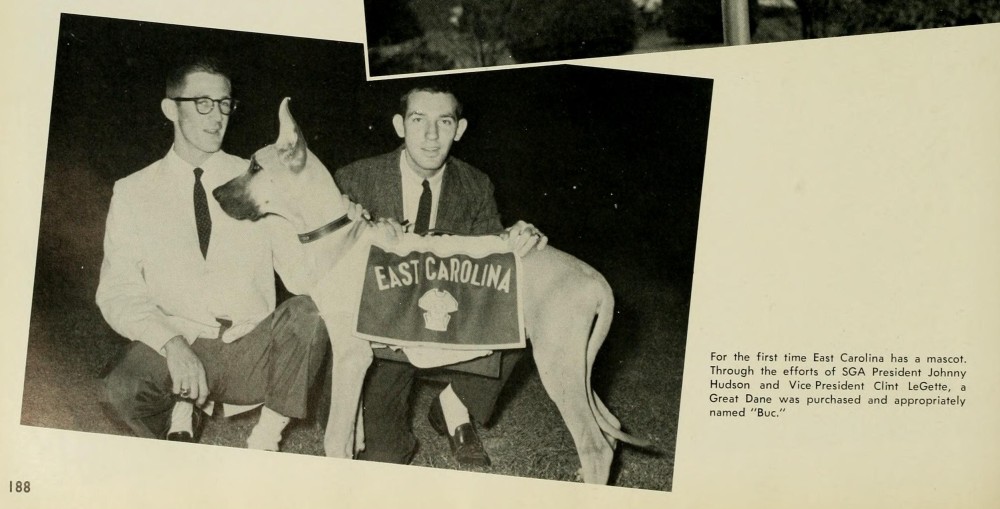
“Buc” is described here as East Carolina University’s first mascot. From the 1959 Buccaneer yearbook.
Characters
While about half of the four-year college mascots in North Carolina are animals, most of the others are characters that are historic, mythical, or extraordinary in nature. From what I’ve seen in NC yearbooks, humans dressing up as the school mascot really got traction in the 1960s. Initially, these costumes weren’t the fuzzy creations we think of today, but rather less complicated ensembles where the mascot’s identity (his or her face and body) was often apparent. Yosef the Mountaineer, beloved icon of Appalachian State University, was created sometime around 1942 and looked like this in the 1960s:
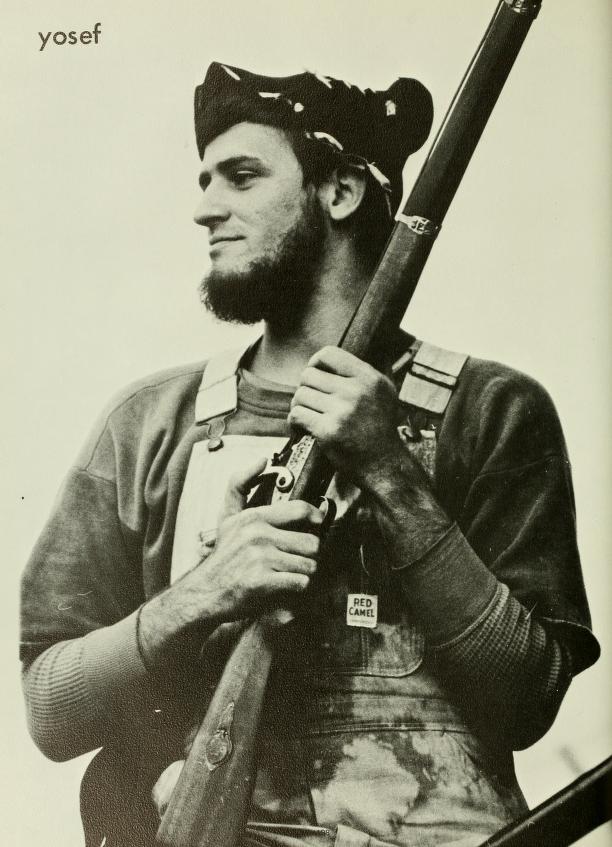
Yosef the Mountaineer, aka James Randle Tedder (we think). From the 1969 Rhododendron yearbook, Appalachian State University.
One of my favorites has to be this picture of Duke Blue Devil, from 1950:
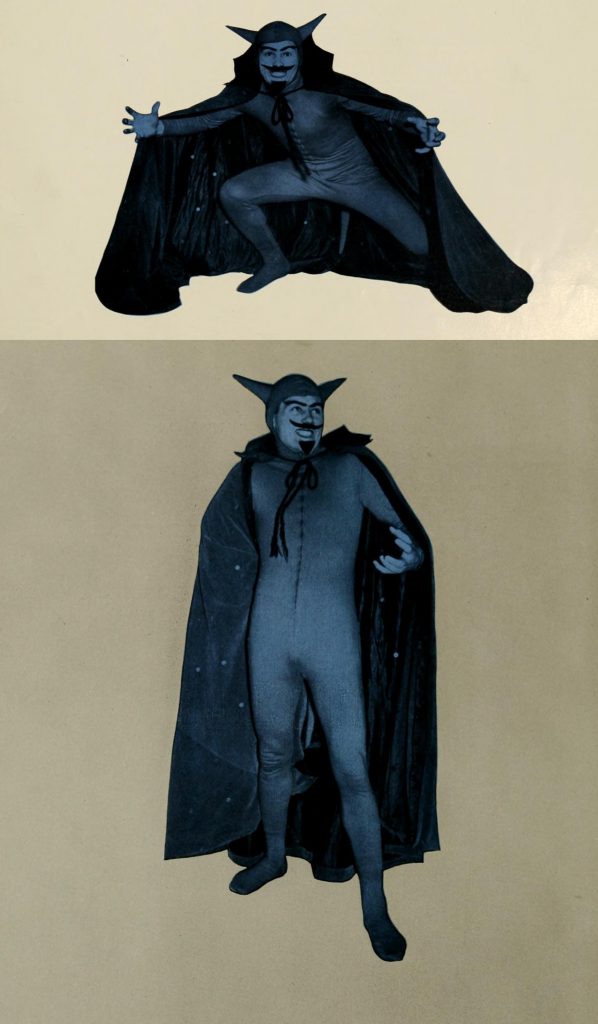
The Blue Devil. From the 1950 Chanticleer yearbook, Duke University.
Perhaps it was too hard to maintain a degree of consistency as students graduated over the years, and mascot anonymity seemed like a better idea. Whatever the reason, you start to see fuzzy, oversized costumes with gigantic headpieces in the late 1970s.
The Big Costumes
Whether animal or character, plush mascots that include a single piece body suit with a large plastic or cloth-covered head is something most Americans can identify with, thanks to professional sports. Colleges in North Carolina really embraced these costumes through the 1980s. Here’s what the UNC-Wilmington Seahawk looked like in 1987:

The Seahawk. From the 1987 Fledgling yearbook, UNC-Wilmington.
Some schools have developed multiple mascots dedicated to different audiences. It seems like the difficulty with these types of costumes is how to pull off a fierce facial expression that doesn’t come off as goofy or too scary for children. I think this picture from Davidson College sums it all up:
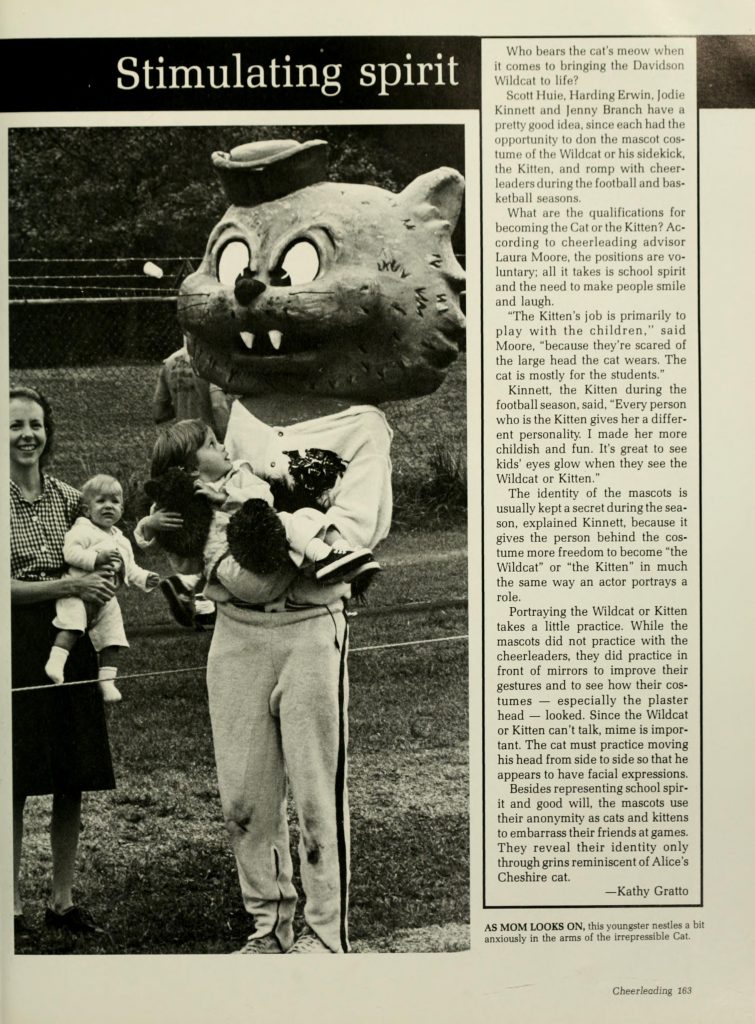
The Davidson Wildcat and … friends. From the 1983 Quips and Cranks yearbook.
I will also take this opportunity to mention a mascot that routinely makes the “wait … what?” list – the Campbell University Fighting Camels:
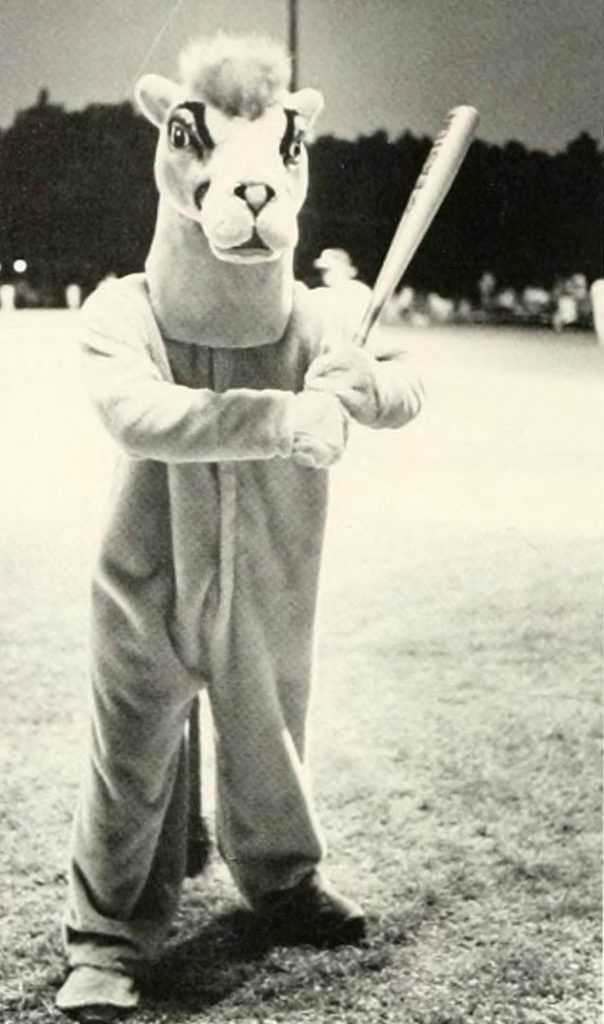
The Campbell Camel. From the 1983 Pine Burr yearbook.
Even the humans and human-like creatures are clothed in oversized costumes these days. Wake Forest University’s Deacon is a dapper chap:
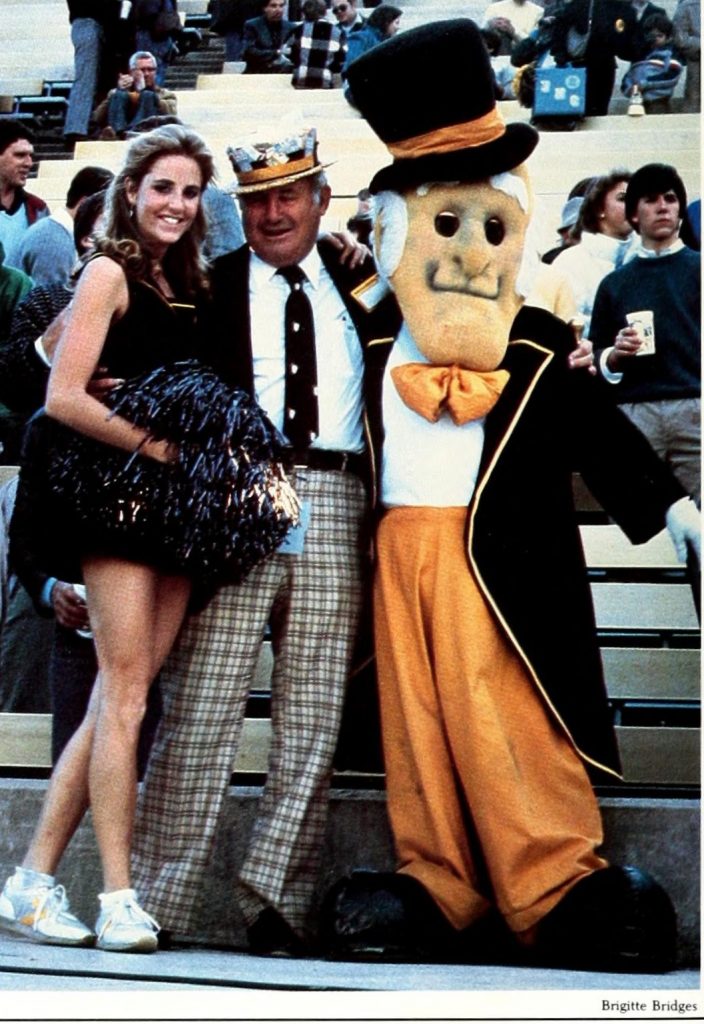
Wake Forest’s Deacon poses with fans. From the 1985 Howler yearbook.
In addition to the Demon Deacons and the Blue Devils, North Carolina boasts a number of other spiritual mascots: North Carolina Wesleyan’s Battling Bishops, Belmont Abbey’s Crusaders, and Guilford College’s Quakers. Meredith College’s teams are known as the Avenging Angels (formerly just the Angels). While Elon University’s mascot is now the Phoenix, before 2000 they were the Fighting Christians:
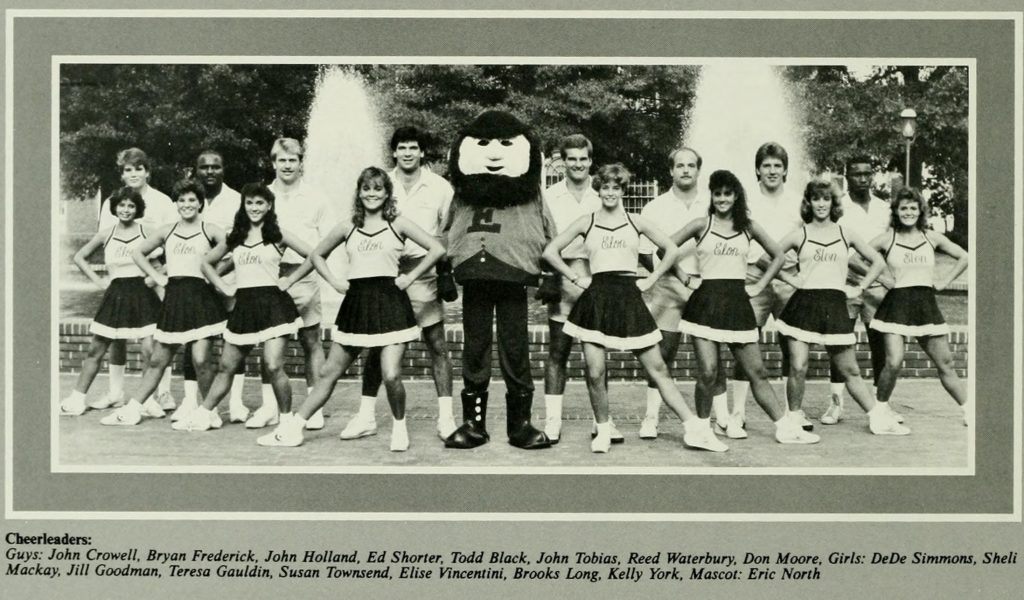
The Elon Fighting Christian mascot with cheerleaders. From the 1986 Phi Psi Cli yearbook.
Two schools break with the animal/human tradition in North Carolina. The Brevard College Tornadoes and the Louisburg College Hurricanes. Weather phenomena mascots are always difficult to pull off. I couldn’t find one for Brevard, but Louisburg, which currently has a bird mascot, had “Louie” up until 2006:
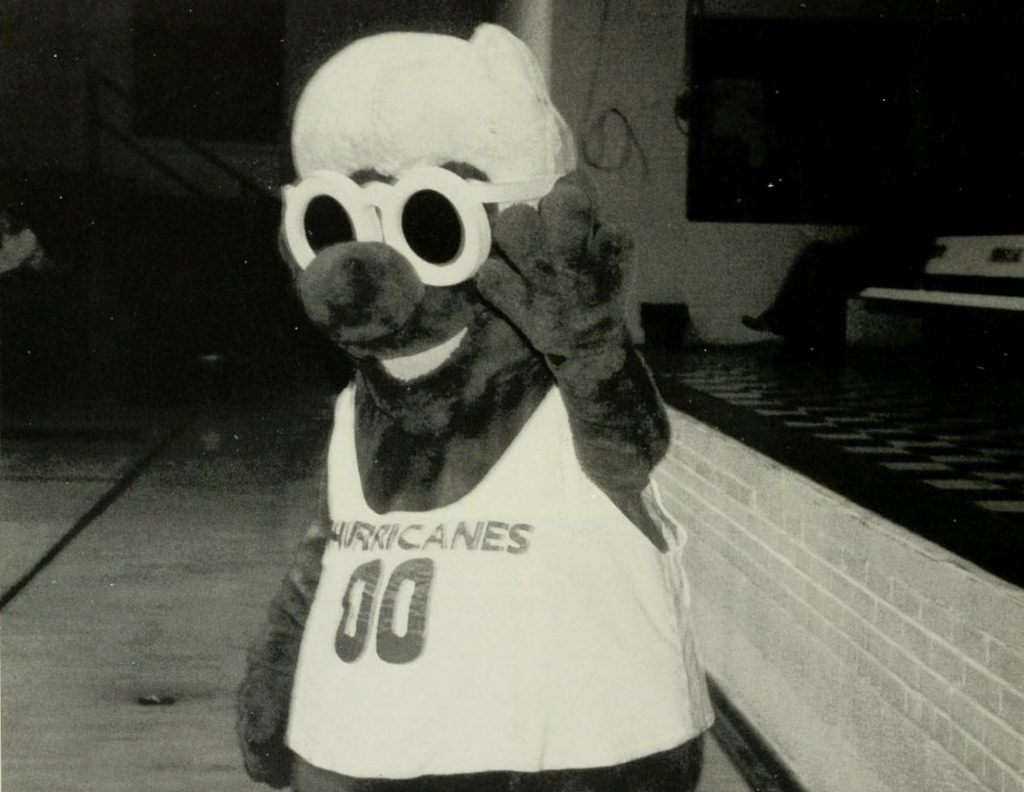
Louie, the former Louisburg College Hurricanes mascot. From the 1996 The Oak yearbook.
Who knows when the next mascot sea change will happen. Below is a list of mascots in North Carolina; let us know if we got anything wrong. Which one is your favorite?
| School |
Mascot |
Notes |
| Appalachian State University |
Yosef the Mountaineer |
First appeared in the yearbook in 1942 |
| Barton College |
Bulldog |
|
| Belmont Abbey College |
Crusader |
|
| Bennett College |
|
Known as the Bennett Belles |
| Brevard College |
Tornado |
|
| Campbell University |
Fighting Camels |
The Hornets in the 1920s-1930s |
| Catawba College |
Catawba Indian |
|
| Chowan University |
Hawks |
The Braves until 2006 |
| Davidson College |
Wildcats |
Also a bulldog (1929) and a bobcat (1939) |
| Duke University |
Blue Devil |
|
| East Carolina University |
Pirates |
Formerly Pee Dee the Pirate |
| Elizabeth City State University |
Vikings |
|
| Elon University |
Phoenix |
The Fightin’ Christians until 2000 |
| Fayetteville State University |
Broncos |
|
| Gardner-Webb University |
Runnin’ Bulldogs |
|
| Greensboro College |
The Pride |
Formerly the Hornets |
| Guilford College |
Quakers |
|
| High Point University |
Panthers |
|
| Johnson C. Smith University |
Golden Bulls |
|
| Lees-McRae College |
Wily the Bobcat |
|
| Lenoir-Rhyne University |
Joe and Josie Bear |
|
| Louisburg College |
Hurricanes |
|
| Mars Hill College |
Mountain Lion |
|
| Meredith College |
Avenging Angels |
Formerly the Angels |
| Methodist University |
Eagles |
|
| Montreat College |
Cavaliers |
|
| Mount Olive College |
Trojans |
|
| North Carolina A&T |
Aggie Dog (Bulldog) |
|
| North Carolina Central University |
Eagles |
|
| North Carolina State University |
Wolfpack |
|
| North Carolina Wesleyan College |
Battling Bishops |
Formerly the Circuit Riders |
| Peace College |
Pacer |
|
| Pfeiffer University |
Falcons |
|
| Queens University of Charlotte |
Rex the Royal |
|
| Saint Augustine’s University |
Mighty Falcons |
|
| Salem College |
Spirits |
|
| Shaw University |
Bears |
|
| St. Andrews University |
Knights |
|
| UNC Asheville |
Bulldog |
|
| UNC Chapel Hill |
Rameses the Ram |
Also known as the Tar Heels |
| UNC Charlotte |
Norm the Niner |
|
| UNC Greensboro |
Spartans |
|
| UNC Pembroke |
Braves |
|
| UNC Wilmington |
Seahawk |
|
| UNC School of the Arts |
Fighting Pickle |
|
| UNC School of Science and Math |
Unicorn |
|
| Wake Forest University |
Demon Deacons |
|
| Warren Wilson College |
Owls |
|
| Western Carolina University |
Catamount |
“Paws” |
| Wingate University |
Bulldog |
|
| Winston-Salem State University |
Ram |
|
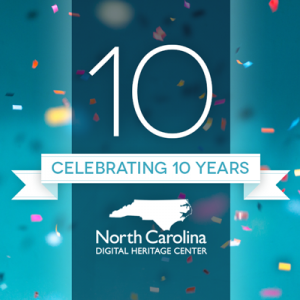 It’s DigitalNC.org’s 10th birthday! Though we had hoped to be in the office celebrating, we’re still taking time to look back at years of hard work and the collaborative spirit that makes the North Carolina Digital Heritage Center (NCDHC) what it is!
It’s DigitalNC.org’s 10th birthday! Though we had hoped to be in the office celebrating, we’re still taking time to look back at years of hard work and the collaborative spirit that makes the North Carolina Digital Heritage Center (NCDHC) what it is!
To date, NCDHC has partnered with 273 libraries, museums, alumni associations, archives, and historic sites in 98 of North Carolina’s 100 counties and we’re growing all the time. Our website currently includes 4.2 million images and files. We share this accomplishment with every institution we’ve worked with. We’d never have gotten to 10 years without staff (permanent, temporary, and student!), our partners, or the network of colleagues all over North Carolina who have encouraged, advised, and supported our work.
As we approached our anniversary, we realized that our website lacked a synopsis of how NCDHC came to be, and our history. So read on for a brief look at how we got started and our major milestones.
Our History
The North Carolina Digital Heritage Center was one outcome of a comprehensive effort by the state’s Department of Cultural Resources (now the Department of Natural and Cultural Resources) to survey and get a broad overview of the status of North Carolina cultural heritage institutions. That effort was entitled NC ECHO (North Carolina Exploring Cultural Heritage Online) and was funded by the Institute of Museum and Library Services (which also supports us – thanks IMLS). A major goal of NC ECHO was a multi-year needs assessment. NC ECHO staff visited hundreds of cultural heritage institutions throughout the state to collect data and interview curators, librarians, volunteers, archivists, and more. Many of our partners still remember their visits!
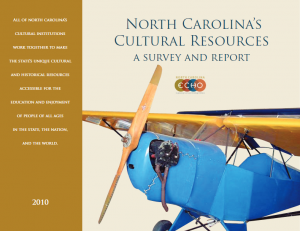 Data collected at these site visits was combined with survey responses to reveal a “state of the state,” summarized in a 2010 report, cover pictured at right. The assessment revealed a lot but, specific to digitization, staff found that nearly three-quarters of the 761 institutions who completed the survey had no digitization experience or capacity. Members of the Department of Cultural Resources (which includes the State Library, State Archives, and multiple museums and historic sites) began brainstorming with other area institutions about a way to help efficiently and effectively provide digitization opportunities. While the NC ECHO project offered digitization grants, workshops, and best practices, an idea emerged of a centralized entity that could assist institutions that didn’t have the capacity to do the work in house. The State Library of North Carolina and UNC-Chapel Hill Libraries joined together to create such an entity: the North Carolina Digital Heritage Center. The Center would be located in Chapel Hill, taking advantage of its central location and the digitization equipment and expertise already available in Wilson Special Collections Library. The State Library would provide funding, guidance, and ongoing promotion and support of the Center’s services.
Data collected at these site visits was combined with survey responses to reveal a “state of the state,” summarized in a 2010 report, cover pictured at right. The assessment revealed a lot but, specific to digitization, staff found that nearly three-quarters of the 761 institutions who completed the survey had no digitization experience or capacity. Members of the Department of Cultural Resources (which includes the State Library, State Archives, and multiple museums and historic sites) began brainstorming with other area institutions about a way to help efficiently and effectively provide digitization opportunities. While the NC ECHO project offered digitization grants, workshops, and best practices, an idea emerged of a centralized entity that could assist institutions that didn’t have the capacity to do the work in house. The State Library of North Carolina and UNC-Chapel Hill Libraries joined together to create such an entity: the North Carolina Digital Heritage Center. The Center would be located in Chapel Hill, taking advantage of its central location and the digitization equipment and expertise already available in Wilson Special Collections Library. The State Library would provide funding, guidance, and ongoing promotion and support of the Center’s services.
At its beginning, the Center’s staff digitized small collections of college yearbooks, needlework samplers, postcards, and photographs and made them available through DigitalNC.org. They went to speak with organizations interested in becoming partners, and began taking projects for digitization. Here’s a list of NCDHC’s earliest partners, who came on board during late 2009 and 2010.
Though we’re not positive of the exact date, we believe DigitalNC.org launched on or near May 12, 2010. Here’s a look at that original site!
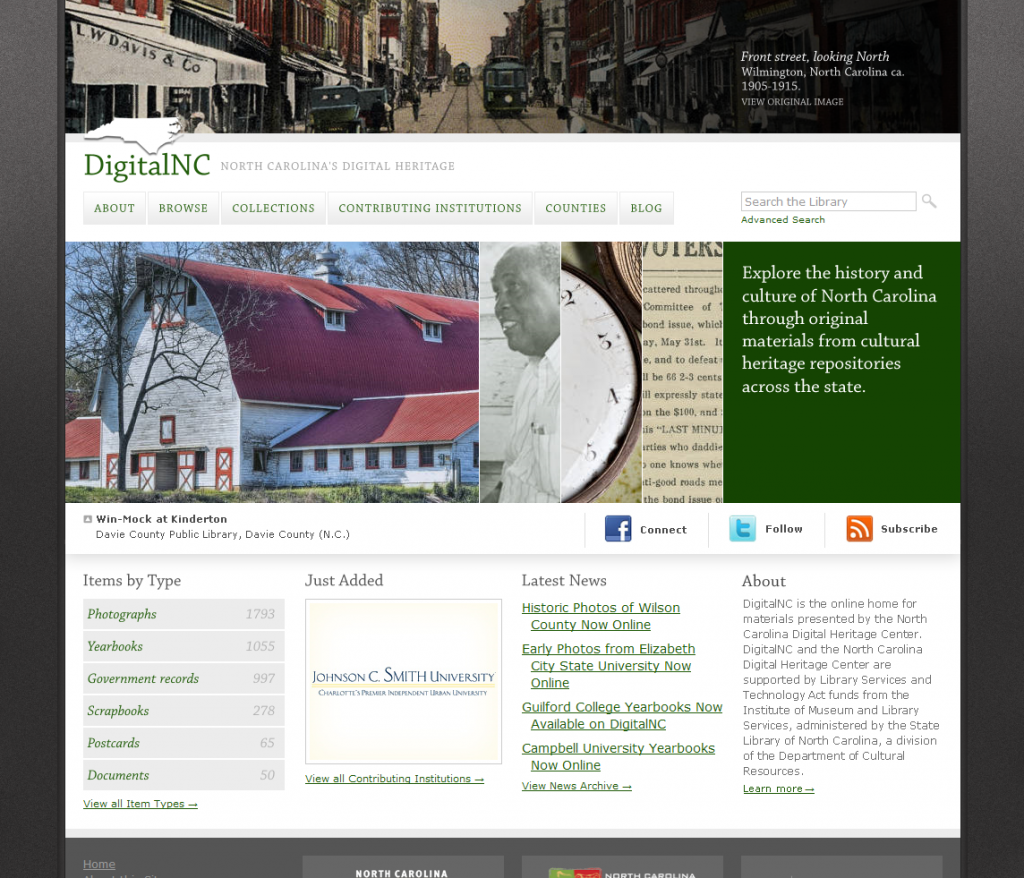
In 2011, word about the Center spread. Staff started responding to demand from partners, incorporating newspaper digitization. In late 2012, also in response to popular demand, the Center began digitizing high school yearbooks. Yearbooks and newspapers are some of the most viewed items on DigitalNC, and they remain a significant portion of our work to this day.
In 2013, NCDHC joined the Digital Public Library of America (DPLA) as North Carolina’s “service hub.” The DPLA collects information from digitized collections all over the nation and provides it together in one searchable interface at dp.la. Because of our participation, users can browse and search for collections from North Carolina alongside items from institutions around the country.
Throughout the years, we’ve tried to expand services to fit our partners’ goals. In 2015, we trialed an audiovisual digitization project that incorporated the first films into DigitalNC. Today, we partner with the Southern Folklife Collection at Wilson Special Collections Library to provide audio digitization on an ongoing basis. In 2016, we added a new partner category – alumni associations – to support more digitization of African American high school yearbooks and memorabilia. The following year, we announced a focus on digitization of items documenting underrepresented communities. We also started going on the road with our scanners! For institutions that don’t have the staff time or resources to travel to Chapel Hill, we offer to come for a day or two and scan on site.
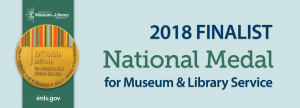 2018 and 2019 saw several major milestones. We were nationally recognized as an Institute of Museum and Library Services National Medal finalist, and we began a major software migration. Both were a tribute to the size and extent of our operation, though in different ways. As we’ve approached our 10th anniversary we’ve focused on working with partners in all 100 of North Carolina’s counties. Whether you’re rural or metropolitan, we believe your history is important and should be shared online.
2018 and 2019 saw several major milestones. We were nationally recognized as an Institute of Museum and Library Services National Medal finalist, and we began a major software migration. Both were a tribute to the size and extent of our operation, though in different ways. As we’ve approached our 10th anniversary we’ve focused on working with partners in all 100 of North Carolina’s counties. Whether you’re rural or metropolitan, we believe your history is important and should be shared online.
One of the ways we’re commemorating this anniversary is to ask our partners and stakeholders how they think we’ve impacted them and their audiences. Join us here on the blog in the second half of 2020 as we share these brief interviews, reflect, and celebrate. Thank you for reading, enjoy the site, and here’s to another 10 years of making North Carolina’s cultural heritage accessible online!
This holiday season join us here on the blog for the 12 Days of NCDHC. We’ll be posting short entries that reveal something you may not know about us. You can view all of the posts together by clicking on the 12daysofncdhc tag. And, as always, chat with us if you have questions or want to work with us on something new. Happy Holidays!
Day 4: Ways to Promote Your DigitalNC.org Collections
While Google is great, intentionally promoting your digital collections to your on-site or website visitors can make sure they’re not missing resources they need. It signals your organization’s commitment to openly sharing your collections, and can lead to some meaningful user engagement. Many of our partners put links to DigitalNC.org on their websites, in visitor or patron guides, or within their catalogs or artifact databases. Here are a few other suggestions you may not know about:
Embed a search widget
We’ve created an embeddable search widget that gives users a quick way to do a keyword search across all of the content on DigitalNC.org. The code provided can be added anywhere that allows an iframe.
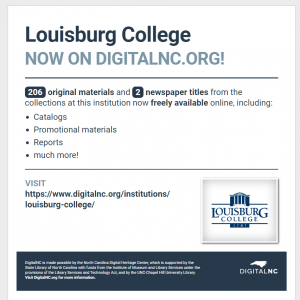 Quickly create a flyer to hand out or post
Quickly create a flyer to hand out or post
Here’s a quick way to create a flyer that includes what we’ve scanned or photographed for your organization. There’s a screenshot of an example at right. In addition to types of items it includes the URL to your landing page and your logo.
Ask us for some brochures
We have a bunch of them! Just contact us and we can mail you some.
Check back on Thursday as we reveal Day 5 of the 12 Days of NCDHC!

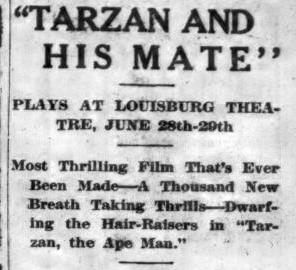
A headline from the June 22nd, 1934 issue of The Franklin Times gives the film “Tarzan and His Mate” a rave review!
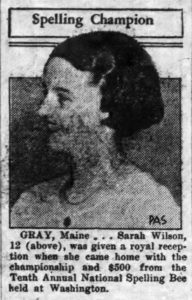
On June 29th, 1934, the 12 year old National Spelling Bee winner from Maine was featured on the front page of The Franklin Times.
More issues of The Franklin Times, provided by our partner, Louisburg College, are now available online. The issues are from the years 1912-1944 and 1963-1972, and join previously digitized issues from 1909-1911. Established in 1870, The Franklin Times covers news in Louisburg, North Carolina, as well as statewide and national news of note. The Franklin Times continues to publish issues on a weekly basis both online and in print form and is distributed throughout Franklin County.
The issues from this batch span a large period of Louisburg’s history, and the paper includes articles on municipal decisions, social and cultural events, meetings, contests, and more at the local level. Large national news stories are also covered, and the paper allows for a glimpse both at life inside and outside Franklin County through the eyes of Louisburg residents throughout much of the 20th century.
To browse through all digitized issues of The Franklin Times, click here. To see more materials from Louisburg College, take a look at their partner page or visit their website.
The following microfilmed newspapers were selected for digitization in 2017-2018. Thanks to supplemental funding from the State Library of North Carolina, we were able to complete more reels than in previous years. Reels were chosen from nominations according to our Criteria for Selecting Newspapers to Digitize from Microfilm.
| Title |
Years |
Nominating Institution |
| Alamance Gleaner (Graham, N.C.) |
1927-1947 |
Alamance County Public Libraries |
| Carolina Indian Voice (Pembroke, N.C.) |
1977-1995 |
UNC Chapel Hill |
| Carteret County News-Times (Morehead City, N.C.) |
1948-1960 |
Carteret County Public Library |
| Charlotte Post |
1971-1987 |
Johnson C. Smith University |
| The Cherokee Scout (Murphy, N.C.) |
1944-1988 |
Murphy Public Library |
| Duplin Times (Warsaw, N.C.) |
1962-1985 |
Duplin County Library |
| Enterprise (Williamston, N.C.) |
1934-1942 |
Martin Memorial Library |
| Farmville Enterprise |
1942-1947 |
Farmville Public Library |
| Franklin Press and the Highlands Maconian (Franklin, N.C.) |
1943-1960 |
Fontana Regional Library |
| The Franklin Times (Louisburg, N.C.) |
1925-1944; 1963-1969 |
Louisburg College |
| Hertford County Herald (Ahoskie, N.C.) |
1914-1923 |
Chowan University |
| Journal-Patriot (North Wilkesboro, N.C.) |
1947-1950 |
Wilkes County Public Library |
| Mount Airy News |
1917-1929 |
Surry Community College |
| News-Record (Marshall, N.C.) |
1976-1988 |
Madison County Public Library |
| Perquimans Weekly (Hertford, N.C.) |
1944-1989 |
Perquimans County Library |
| Pilot (Southern Pines, N.C.) |
1948-1965 |
Southern Pines Public Library |
| The Roxboro Courier (Roxboro, N.C.) |
1927-1935 |
Person County Public Library |
| Smithfield Herald |
1901-1911 |
Johnston County Heritage Center |
| Transylvania Times (Brevard, N.C.) |
1933-1940 |
Transylvania County Library |
| Watauga Democrat (Boone, N.C.) |
1950-1963 |
Watauga County Public Library |
| Waynesville Mountaineer |
1952-1956 |
Haywood County Public Library |
| Winston-Salem Chronicle |
1997-2016 |
Forsyth County Public Library |

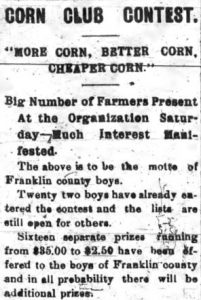
A column in the Feb 11, 1910 issue urging boys from Franklin County to enter an upcoming corn growing competition.
Over 100 issues of The Franklin Times, provided by our partner, Louisburg College, are now up on DigitalNC. These issues are from 1909-1911, and were published on a weekly basis. Louisburg is the seat of Franklin county, and The Franklin Times reports on news taking place in Louisburg, Franklin County, North Carolina, and the United States. In fact, the tagline printed at the top of the paper reads “the County, the State, the Union.” Although some large national news stories are covered, many of the issues focus primarily on Louisburg and Franklin County. For example, one weekly column, “The Moving People,” tracks “those who have visited Louisburg the past week” and “those who have gone elsewhere for business or pleasure.” The column lists individuals who returned from trips and those who visited from afar. This is indicative of the paper’s local interest. Local meetings, contests, municipal issues, social events, and more are recounted each week.
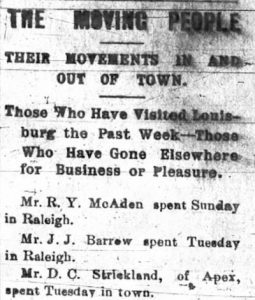
Part of the “Moving People” column from the February 11, 1910 issue.
The Franklin Times was established in 1870, but still runs weekly with a print and online version. The Franklin Times website states, “it is the only newspaper published in the county and its content is focused on local government, local schools, the communities and the people who call this rapidly growing area home.” Although many years have passed, the focus of the paper remains the same.
To see more materials from Louisburg College, visit their partner page, or website.
The following microfilmed newspapers have been selected for digitization in 2016-2017. Around 70 reels were chosen from over 1,100 nominated reels, according to our Criteria for Selecting Newspapers to Digitize from Microfilm.
| Title |
Years |
Nominating Institution |
| Carolina Indian Voice (Pembroke, N.C.) |
1996-2005 |
UNC-Chapel Hill |
| The Cherokee Scout (Murphy, N.C.) |
1923-1943 |
Murphy Public Library |
| The Daily Advance (Elizabeth City, N.C.) |
1923-1927 |
Pasquotank County Public Library |
| Farmville Enterprise (Farmville, N.C.) |
1914-1941 |
Farmville Public Library |
| The Franklin Times (Louisburg, N.C.) |
1909-1924 |
Louisburg College |
| The Future Outlook (Greensboro, N.C.) |
1941-1972 |
UNC-Greensboro |
| The Roxboro Courier (Roxboro, N.C.) |
1922-1929 |
Person County Public Library |
| State Port Pilot (Southport, N.C.) |
1935-1949 |
Margaret and James Harper Jr. Library |
| Washington Daily News (Washington, N.C.) |
1909-1916 |
George H. and Laura E. Brown Library |

In today’s blog post I offer a break from the current election year with a trip back to the 1968 presidential election. Looking at the political landscape of 1968 is like looking at an earlier but familiar view of the same neighborhood we’re in now. It’s issues resonate today: striving for social and racial equality, debates over America’s place on the world stage. The late 60s were boiling with the turmoil of the Civil Rights Era and the Vietnam War. 1968 alone saw the assassination of Dr. Martin Luther King, Jr. in early April and presidential candidate Robert F. Kennedy in June.
In April 1968, Time magazine held a mock presidential primary at colleges and universities to take the temperature of young Americans during that election year. Dubbed “CHOICE 68,” the event was covered in many of the student newspapers that can be found on DigitalNC, and I wanted to see what this nation-wide event looked like here in North Carolina.
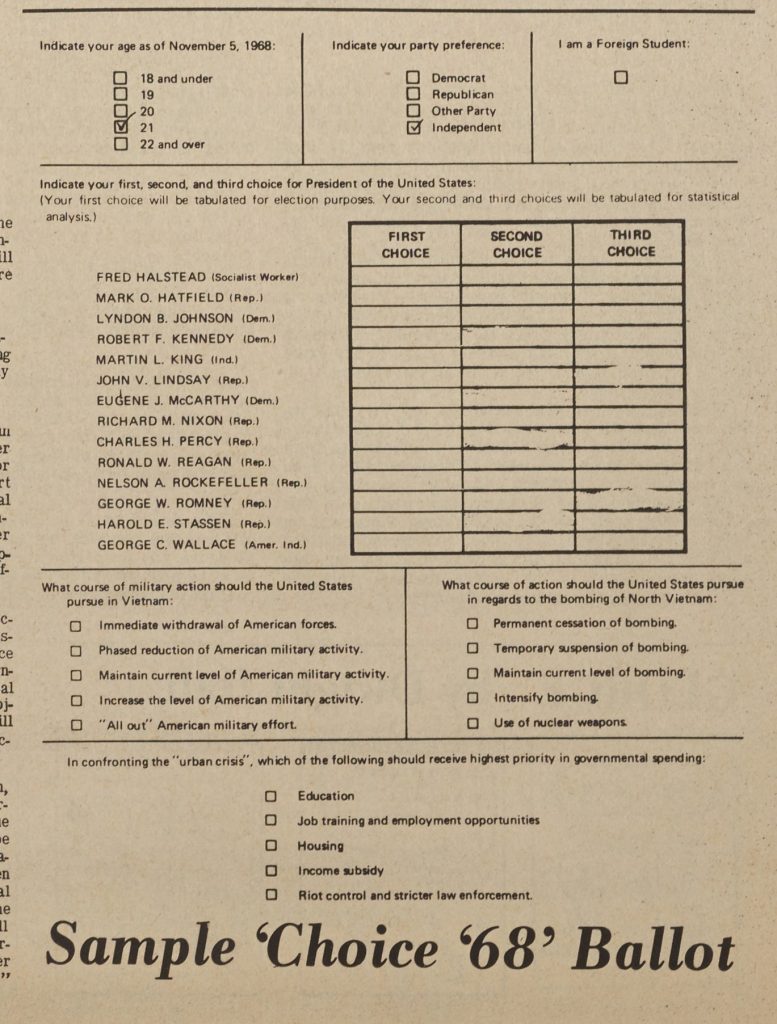
Sample Choice 68 Ballot, printed in Asheville-Biltmore College (now UNCA) newspaper The Ridgerunner, March 1, 1968.
Every American college and university was asked to participate in CHOICE 68. The event was governed by a group of eleven students representing a variety of campuses around the country. Campus groups were in charge of publicizing the event with their peers, under the direction of a campus coordinator. Each ballot (an early draft is shown at right) asked students to rank their top three choices for president and also asked for them to weigh in on Vietnam and the “urban crisis,” the latter of which referred to pervasive concern over poverty, crime, and general unrest in high population urban environments. Write-in candidates were also allowed. Votes from all campuses were tabulated by a UNIVAC computer in Washington, D.C. and the results were supposedly announced on television, with each school’s individual totals being returned during the first week of May.
Before the vote, student newspapers urged their readers to rally against apathy, to prove that young voters could impact the national arena. One Brevard College editorial called on moderates to vote, expressing frustration that liberal and conservative activists had been “hoarding the headlines.” An accompanying editorial talked about the conservatives still being committed to rooting out Communism, revealing lingering echoes of McCarthyism from the late 50s. It predicted a 1968 election win for then Governor of California, Ronald Reagan.
Campuses with active student government associations and/or political groups tended to have more events and publicity associated with CHOICE 68. North Carolina Wesleyan College’s student body listened to speeches in support of Senator Eugene McCarthy (D), former Vice President Richard Nixon (R), and current Vice President Hubert Humphrey (D), three of the most prominent contenders in early 1968. Voting booths, borrowed from the City of Rocky Mount, housed students punching out chads of computer cards to cast their votes.
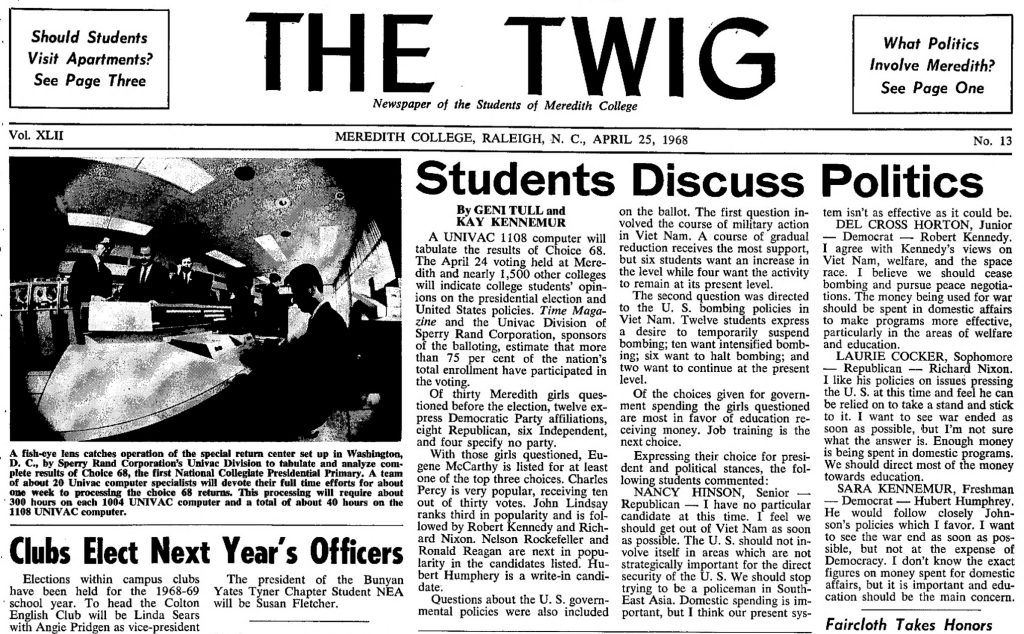
Headline from the April 25, 1968 issue of The Twig, Meredith College.
Some schools had hundreds of participants, with 500 Elon students voting in the mock election. Others had fewer; thirty students were questioned at Meredith College. The Twig quoted opinions from four of those 30 (two Republicans and two Democrats) in the issue seen at right.
Salem College appears to have been one of the most enthusiastic participants, with articles about CHOICE 68 found in issues spanning January through May and a voter turnout of 73% of the eligible student body. The February 23 issue of The Salemite talked about how President Lyndon Johnson endorsed the national mock election despite the fact that “student dissent over the past year ha[d] been directed primarily against White House policies.” The April 12 issue asserted that “massive student participation in CHOICE 68 can and will affect the course of American politics in 1968.”
Almost all articles about the vote mentioned the UNIVAC computation of results, which was seen as heralding a new era in which computers could make generating results faster and more secure. The Meredith College Twig published a photo of the computer tabulating results in its April 25 issue (shown above). Dr. Hammer of UNIVAC posited a time when “a huge data bank may contain ‘voice prints’ of eligible voters” to authenticate those phoning in their votes (“A Letter from the Publisher,” Time, May 10, 1968, page 21).
Of the North Carolina schools* whose CHOICE 68 results I could locate, McCarthy came out on top for all except North Carolina State University, where Nixon prevailed and McCarthy came in second. Nixon was the second choice for 7 schools, and Nelson Rockefeller (R) carried second choice at the remaining 3.
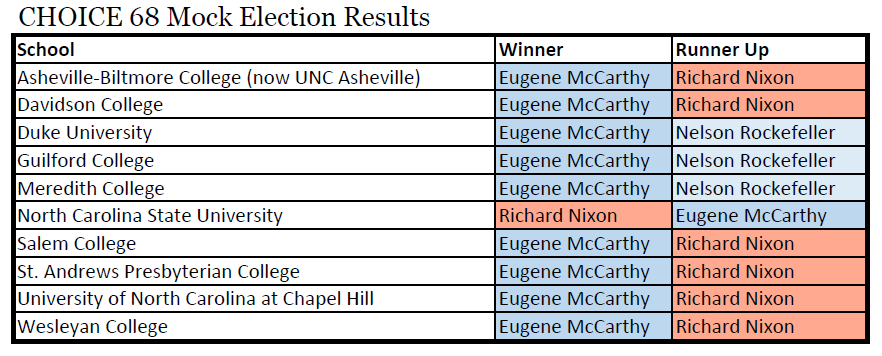
The national CHOICE 68 vote also saw McCarthy in the lead with 286,000 out of 1.7 million votes from 1,450 campuses. Robert Kennedy (D) and Nixon followed behind McCarthy. Students voted to reduce the United States military presence in Vietnam, and saw education as the biggest key to solving the “urban crisis.”
Though he won the CHOICE 68 vote and continued to be bolstered by student support through the primaries, McCarthy was beaten by Humphrey to gain the official Democratic nomination. The November election was won by Nixon, however the CHOICE 68 voters’ preference for a Democratic candidate was somewhat predictive: Humphrey prevailed with voters under 30 in the general election.
As far as I can tell, no nationwide poll quite like CHOICE 68 has been held since, though speculation over how college-aged Americans will vote certainly hasn’t changed. If you’re interested in other historical election news and opinion as reported by student newspapers, visit the North Carolina Newspapers collection.
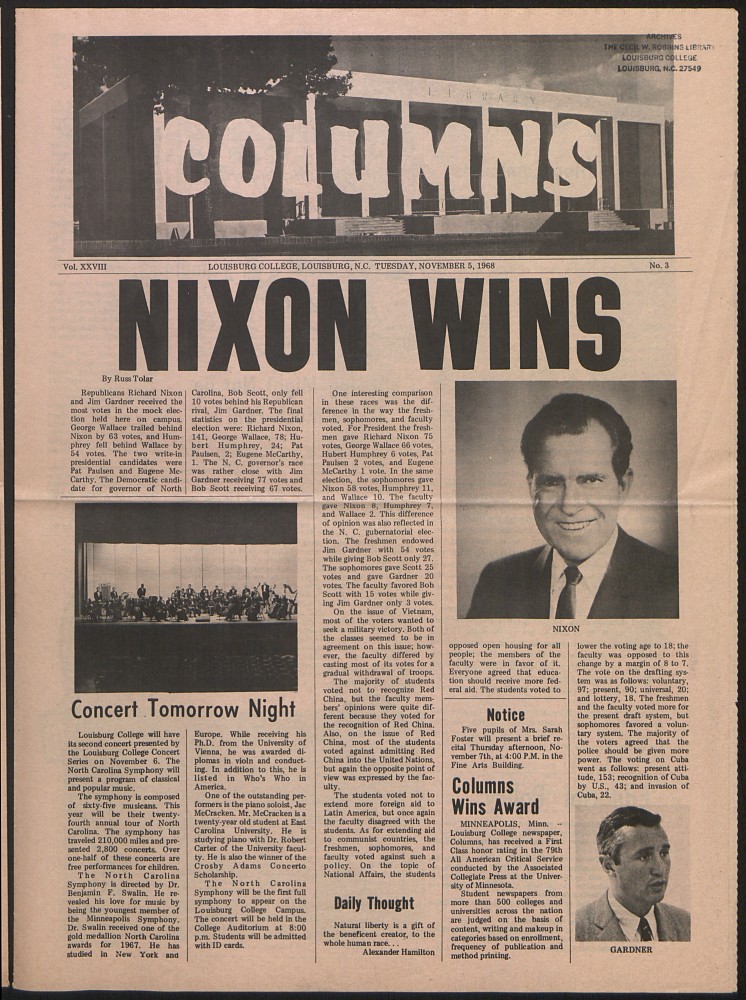
November 5, 1968 issue of the Louisburg College Columns student newspaper. Students picked Nixon in a straw poll held close to the general election.
*It appears that the following schools also participated in CHOICE 68 based on mentions in newspapers and yearbooks, but no results were found: Appalachian State University, High Point College, Lees-McRae College, Lenoir-Rhyne College, Queens College, and University of North Carolina at Greensboro.

Elon’s The Pendulum staff publishes their ACC picks in 1991.
As you scramble to fill out your brackets, we at the North Carolina Digital Heritage Center thought it would be fun to see how the ACC tournament has been discussed across the state throughout the years since the tournament started in the 1950s. While we all know the big names in the tournament who call North Carolina home, many of the state’s smaller institutions have had a lot to say on the tournament over the years as well, even if their own school or anyone from their town is not participating. A look through the newspapers we have in DigitalNC shows that North Carolina is truly basketball country, especially in March.
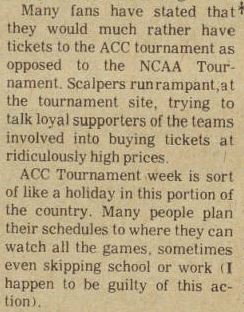
The columnist from the Clarion, Brevard’s student newspaper, in 1979 describing the tournament atmosphere in NC much as one finds it today.
The quote from the article above, from 1979, goes to show that the hyper-attention on the tournament is nothing new. Productivity in North Carolina during this week in March has always been rather low!
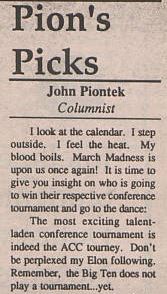
Elon’s student newspaper sports columnist in 1994 brushes off criticism for focusing on the ACC tournament by noting Elon doesn’t participate in any yet.
It seems that all the sports columnists in both town and other institution’s student newspapers had an opinion to offer on who they think will win the tournament that year and overall commentary on the tournament and how it stands up to others for the sport. Many of the columnists remark that having grown up in North Carolina they always followed the tournament, and so brush off any criticism over the fact their own school isn’t participating so why offer commentary?
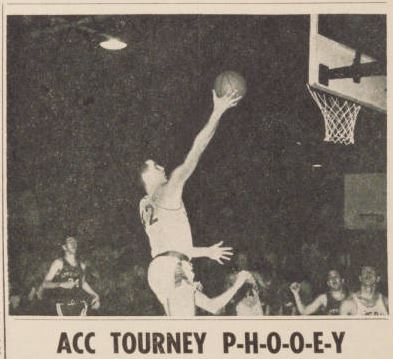
Headline for an article from Louisburg College’s “Columns” student newspaper in 1964, arguing the ACC tournament does not properly reward the best team in the ACC.
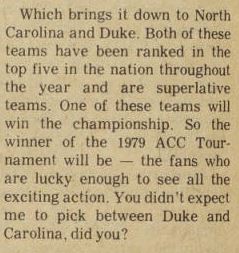
The other student newspapers across the state don’t tend to pick between the big blue rivalry. This is from the Clarion, Brevard College’s student newspaper, in 1979.
Duke and Carolina is the repeated rivalry throughout the sports columns discussing the tournament. There is even a column from Raeford’s The News-Journal that laments that North Carolina State University beat Duke in the first round of the tournament, noting that Duke was clearly the best team in the country.
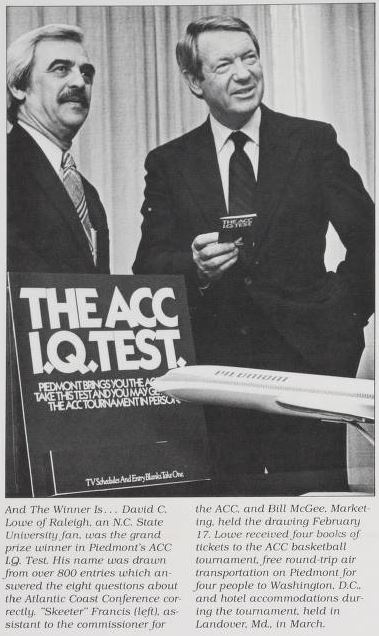
The airlines got in on the ACC fun too. This photograph from Piedmont Airlines’ company paper shows the winner of their ACC trivia contest, with a prize of roundtrip tickets to the tournament in 1981.
To view more ACC tournament news from the past and check out more North Carolina newspapers in general, visit the North Carolina Newspapers page. And as the NC Digital Heritage Center staff’s only bias is for all things North Carolina, we wish the Wolfpack, Deacons, Blue Devils, and Tar Heels well this week!
































